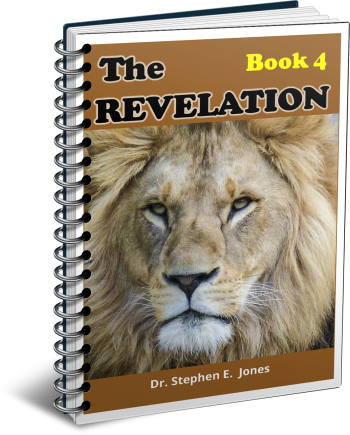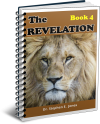Latest Posts
View the latest posts in an easy-to-read list format, with filtering options.

A study of Revelation 10-12. This is book 4 of an 8 part book series.
Category - Bible Commentaries

Revelation 12:13, 14 says,
13 And when the dragon saw that he was thrown down to the earth, he persecuted the woman who gave birth to the male child. 14 And the two wings of the great eagle were given to the woman, in order that she might fly into the wilderness to her place, where she was nourished for a time and times and half a time.
I have already mentioned previously that the 3½ “times” in the wilderness differs from Israel’s 40-year wilderness sojourn under Moses. But the 3 ½ times does not date from the day of Pentecost in Acts 2, but from Justinian’s decree. The basic pattern for the church is actually quite similar to that of the church in the wilderness under Moses. Israel’s 40-year wilderness experience was based on the principle of a year for a day (Num. 14:34); the last pattern is a Jubilee cycle for a year. Forty Jubilees is 1,960 years, dating from 33 to 1993 A.D., which ended the Age of the Church under Pentecost and began the transition into the Tabernacles Age.
But Rev. 12:14 tells us that the woman’s wilderness sojourn was “for a time and times and half a time,” using Daniel’s terminology in Dan. 7:25. This is 3½ “times,” or half of the seven times of divine judgment specified in Lev. 26:18, 21, 24, etc. for their refusal to be obedient to the law of God in fulfillment of their vow (covenant).
Why is there a difference? First of all, the original forty-year judgment for Israel under Moses was an extension of the law found in Deut. 25:3, where the maximum punishment for misdemeanors was forty lashes. The “seven times” judgment was for greater sin—in this case, Israel’s persistent refusal to be obedient.
We should view Israel’s 40 years in the wilderness as a time in which God gave Israel 40 lashes. The same is true with the church in the Pentecostal Age, where they were to wander for 40 Jubilees (1,960 years). This time period coincided largely with the 1,260 years, and both were part of the “seven times” of captivity. All of these cycles are valid and important in understanding the complete picture.
The seven times (i.e., 7 x 360 years) is not divisible by 40, but by 210, which is the “time of Jacob’s distress” (Jer. 30:7). The number 210 is based on 21, which is the number of “distress.” Jacob experienced two such times. The first was when he worked for Laban who oppressed him for most of his 20 years. Jacob’s 21st year (when he returned to Canaan) was a Sabbath year, so it is reckoned as part of this cycle, much like any vacation/holiday year. The second 21-year cycle was when he was separated from Joseph, the birthright holder.
However, 210 is also a factor in dedicating the altar (by extension, the tabernacle itself) in Num. 7:13, 14. There we find that each of the 12 tribes contributed one silver dish weighing 130 shekels, one silver bowl weighing 70 shekels, and one golden spoon weighing 10 shekels. The weight of each tribal gift was 210 shekels. Twelve such gifts weighed 2,520 shekels, which is “seven times.”
We see from this that the “seven times” of divine judgment upon Israel had a positive side to it. God used the time in a legal way to inflict judgment, but also He used it to rebuild, for on the prophetic level it was a lengthy “dedication” ceremony. Seeing the positive side of this 2,520 year cycle, we may view Israel’s judgment in a positive light, for God is building a temple even while inflicting judgment, or “distress.”
Israel began to be deported by the Assyrians in 745 B.C., and 2,520 years later was the year 1776 A.D., when they began to be regathered in the New World with the motto: e pluribus unum, “out of many, one.” Israel’s capital, Samaria, was destroyed in 721 B.C., and 2,520 years later the United States capital, Washington D.C., was built, and the new government moved to that location from Philadelphia.
This took place in 1800 A.D. during the transition from the beast of the sea to the beast of the earth in Revelation 13, as we will see later. This also took place in the early years of the Philadelphia church era (1776-1914).
The establishment of the United States in 1776 and the building of the new nation’s capital in 1800 were 2520-year endpoints dating from the captivity of Israel and the fall of Samaria. The same cycle applies also to the captivity of Judah and Jerusalem. Israel was taken to Assyria, never again to return. Judah was taken to Babylon for just seventy years (Jer. 25:11).
Israel’s captivity was set at 7 x 360 years; Judah’s captivity was set at 7 x 10 years. Both captivities were thus “seven times,” but the “time” was different in each case.
Judah’s captivity came after the fall of Assyria, when Babylon established itself as an empire in 607 B.C. and then took Jerusalem in 604 B.C. These dates were starting points for other 2,520-year cycles that ended in 1914-1917 at the end of the Philadelphia church era and the start of the Laodicean. So Philadelphia’s time essentially was the interim between the endpoints for Israel and for Judah. This is also why, I believe, the city of Philadelphia—named after the biblical city—was a key city in the prophetic history of the United States.
I have also shown in many other places that the endpoints of 1914-1917 were extended for a century on legal grounds, because the third beast (the Greek beast under Antiochus Epiphanes) had been deprived of a full century to rule Judah and Jerusalem from 163-63 B.C. Since God had contracted these “beasts” to judge and scourge Judah for seven times, this time had to be added to 1914-1917 in order to fulfill the legal contract. This brings us to 2014-2017, when the contract fully expires.
Dan. 7:25 tells us that the time of the little horn is the extension of the iron beast of Rome, and that his time of dominion is “a time, times, and half a time.” In other words, this little horn is given the final half of the full seven times. This is an enormous amount of time, because the other half had to be divided among each of the other beasts.
John’s statement in Rev. 12:14 that the woman was sent into the wilderness for “a time, times, and half a time” links her wilderness experience (where she is persecuted) with the time of the little horn who persecutes her.
Throughout many past generations, Christians have been part of the woman in the wilderness, whether they understood this or not. They have prayed for deliverance during hard times without a clear understanding of the reasons for divine judgment. In fact, most have attributed their troubles to the work of the dragon, rather than to the judgments of God. To understand the cause of these troubles, one must go back to Scripture and see how the sins of our fathers brought judgment upon their children for many generations.
Scripture reveals the solution to the problem—repentance and obedience. Better yet, Scripture gives hope that all divine judgments come to an end, for judgment is directly proportional to the crime (sin). The value of understanding prophecy is that it gives answers to the length of time allotted to all divine judgment. We need only to obtain an understanding of the laws of time to know where we fit into the big picture and when these judgements must end.
When Rev. 12:6 speaks of the “wilderness,” John uses the Greek word eramos, which means “a solitary, lonely, desolate, deserted, uninhabited place.” As usual, although John uses Greek to express his revelation, he is thinking with the Hebrew mindset, so we must go back to the Hebrew word for wilderness, which is midbar. The Hebrew word describes a place not nearly as bleak as the Greek word, for it includes pastures and does not include a desert.
So the wilderness wherein the woman flees is not a Sahara-like setting of barren sand dunes blowing in the wind. It is a pasture where she can be fed, or “nourished” (Rev. 12:14). The main overlap between the Hebrew and Greek concept is that it is a place where she can be alone while she grows and gains strength.
The Hebrew word midbar is used in 1 Sam. 23:14,
14 And David stayed in the wilderness [midbar] in the strongholds, and remained in the hill country in the wilderness [midbar] of Ziph. And Saul sought him every day, but God did not deliver him into his hand.
In the Greek translation (Septuagint), midbar is translated eramos, showing that eramos is the Greek way of expressing the Hebrew concept of midbar. Why this this important? Midbar is a noun that is derived from the root word dabar (the verb form). According to Hebrew expositors, the word dabar means “to speak,” but it implies “a driving of the Word” into new and unexplored territory. So we read in Matt. 4:1,
1 Then Jesus was led up [anago, “to set sail, launch, drive”] by the Spirit into the wilderness to be tempted by the devil.
The wilderness itself is the place where one is driven by the word and by the Spirit in order to receive nourishment from the word or revelation of God. David experienced this while he was being persecuted by Saul. The woman likewise is persecuted by the Saul Church and flees into the wilderness not only for protection, but to receive a divine revelation of truth.
Hence, the wilderness is not wasted time, nor is it a mere dungeon or cage where nothing is accomplished. The wilderness is a place of spiritual growth and experience in learning how to hear His voice in order to receive the revelation of the word. The woman in Revelation 12 is persecuted by the dragon in the heavenly signs, but on earth, the practical reality is that the Roman church persecuted those who claimed Sarah as their spiritual mother. This is a direct parallel to Saul persecuting David, for Saul was crowned on Pentecost and is a type of the corrupted church in rebellion against God.
Nonetheless, God uses this wilderness time to bring the revelation of the word as He builds His new temple, and this principle applies to every individual who has ever been led into the wilderness for further training. This was also the topic of my book, The Purpose of the Wilderness.